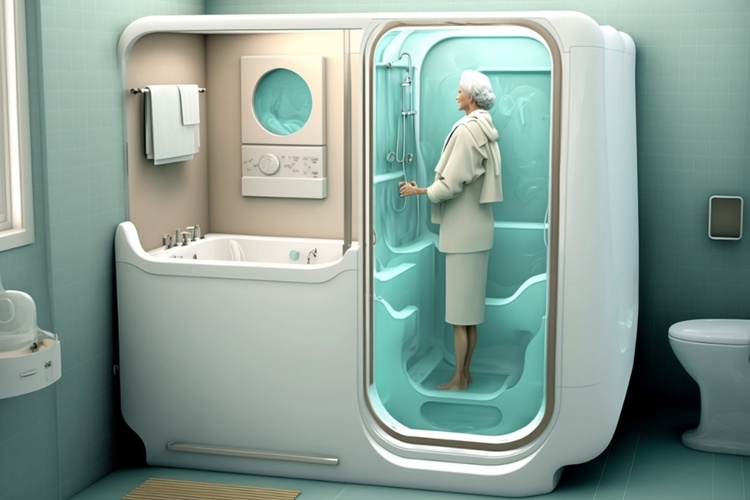Walk-In Tubs: Enhancing Bathroom Safety and Accessibility
Walk-in tubs represent a significant advancement in bathroom design, offering enhanced safety and accessibility for individuals with mobility challenges. These specialized bathing solutions combine therapeutic benefits with practical features that make independent bathing possible for seniors and those with physical limitations. Understanding the various aspects of walk-in tubs can help homeowners make informed decisions about this important bathroom modification.

Walk-in tubs have become an increasingly popular bathroom modification for households seeking to improve safety and accessibility. Unlike conventional bathtubs that require stepping over a high threshold, these specialized tubs feature a watertight door that allows users to enter at ground level. This design addresses the challenges faced by individuals with limited mobility, balance issues, or physical disabilities, making bathing a less stressful and safer activity.
How Do Walk-In Tubs Enhance Bathroom Accessibility?
The primary advantage of walk-in tubs lies in their low-threshold entry design. Traditional bathtubs typically have a wall height of 14 to 18 inches, which can be difficult or impossible for some individuals to navigate safely. Walk-in tubs reduce this barrier to as little as 3 to 6 inches, significantly lowering the risk of trips and falls. The watertight door seals securely once closed, allowing the tub to fill with water while the user is comfortably seated inside. Many models also include built-in seating, textured flooring to prevent slipping, and strategically placed grab bars that provide additional stability during entry, exit, and bathing. These features collectively create an environment that promotes independence while minimizing the need for caregiver assistance.
What Features Come Standard in a Walk-In Tub?
Most walk-in tubs are equipped with several standard safety and comfort features. A built-in seat, typically positioned at a comfortable height, allows users to bathe while seated rather than lowering themselves to the tub floor. Anti-slip flooring provides traction even when wet, reducing the likelihood of slipping. Grab bars are installed at convenient locations to assist with balance and movement. The door itself is designed with multiple seals to prevent leaks and is engineered to withstand water pressure. Many units also include handheld showerheads with adjustable spray settings, allowing users to control water flow and direction easily. Temperature controls with anti-scald technology help prevent burns by maintaining safe water temperatures. Additionally, some models offer therapeutic features such as hydrotherapy jets or air massage systems, which can provide relief for sore muscles and joints.
What Are the Benefits of Walk-In Tubs for Seniors?
For older adults, walk-in tubs offer numerous advantages that extend beyond basic safety. The reduced risk of falls is paramount, as falls are a leading cause of injury among seniors. The ability to bathe independently helps maintain dignity and self-esteem, which are important factors in overall well-being. The seated bathing position is less physically demanding than standing in a shower or maneuvering in a traditional tub, making daily hygiene routines more manageable. Therapeutic features like warm water immersion and hydrotherapy jets can help alleviate arthritis pain, improve circulation, and reduce muscle tension. The calming effect of a warm bath can also promote relaxation and better sleep quality. For seniors who wish to age in place, installing a walk-in tub can be a valuable investment that allows them to remain in their homes longer while maintaining their bathing independence.
What Are the Cost Considerations for Walk-In Tubs?
When evaluating walk-in tubs, understanding the financial investment is essential. The total cost typically includes the tub unit itself, installation labor, and any necessary plumbing or electrical modifications. Basic models generally start around $2,000 to $5,000, while mid-range options with additional features like hydrotherapy jets can range from $5,000 to $10,000. Premium models with advanced therapeutic systems, custom finishes, and luxury features may exceed $10,000 to $15,000 or more. Installation costs vary widely based on existing bathroom configuration and can add $1,000 to $5,000 to the total expense. Some homeowners may qualify for financial assistance through insurance, Medicare Advantage plans, Medicaid waivers, or veterans benefits, though coverage varies by plan and eligibility criteria. Tax credits or deductions for medical expenses may also apply in certain situations.
| Provider | Product Type | Key Features | Estimated Cost Range |
|---|---|---|---|
| Kohler | Walk-In Bath | Low threshold entry, built-in seat, hydrotherapy jets, heated surfaces | $4,000 - $12,000 |
| Safe Step | Walk-In Tub | Anti-slip floor, grab bars, quick drain system, therapeutic jets | $5,000 - $15,000 |
| American Standard | Accessible Bathtub | ADA-compliant design, dual hydrotherapy systems, low step-in | $3,500 - $10,000 |
| Ella’s Bubbles | Bariatric Walk-In Tub | Extra-wide door, reinforced seating, air massage system | $4,500 - $11,000 |
| Ariel Bath | Soaking Walk-In Tub | Chromotherapy lighting, ozone sterilization, digital controls | $3,000 - $9,000 |
Prices, rates, or cost estimates mentioned in this article are based on the latest available information but may change over time. Independent research is advised before making financial decisions.
How Should Walk-In Tubs Be Maintained and Cleaned?
Proper maintenance ensures that walk-in tubs remain safe, hygienic, and functional for years. Regular cleaning with non-abrasive cleaners prevents soap scum buildup and keeps surfaces sanitary. The door seals should be inspected periodically and wiped down to prevent mold or mildew growth. If the tub includes jets or air systems, these should be flushed according to manufacturer instructions to prevent bacterial growth in the plumbing lines. Most manufacturers recommend running a cleaning solution through the jet system monthly. The drain and overflow should be checked for clogs or slow drainage, as proper water evacuation is essential for the tub to function correctly. Any mechanical components, such as the door latch or hinges, should be examined for wear and lubricated as needed. Following the manufacturer’s maintenance schedule and addressing minor issues promptly can prevent more costly repairs down the line.
Conclusion
Walk-in tubs represent a meaningful investment in safety, accessibility, and quality of life for individuals with mobility challenges. By reducing fall risks, promoting independence, and offering therapeutic benefits, these specialized fixtures address both practical and wellness needs. While the initial cost may seem substantial, the long-term advantages of remaining safely in one’s home and maintaining personal care independence often outweigh the financial considerations. Careful research into available models, features, and potential financial assistance can help families make informed decisions that best meet their specific needs and circumstances.




